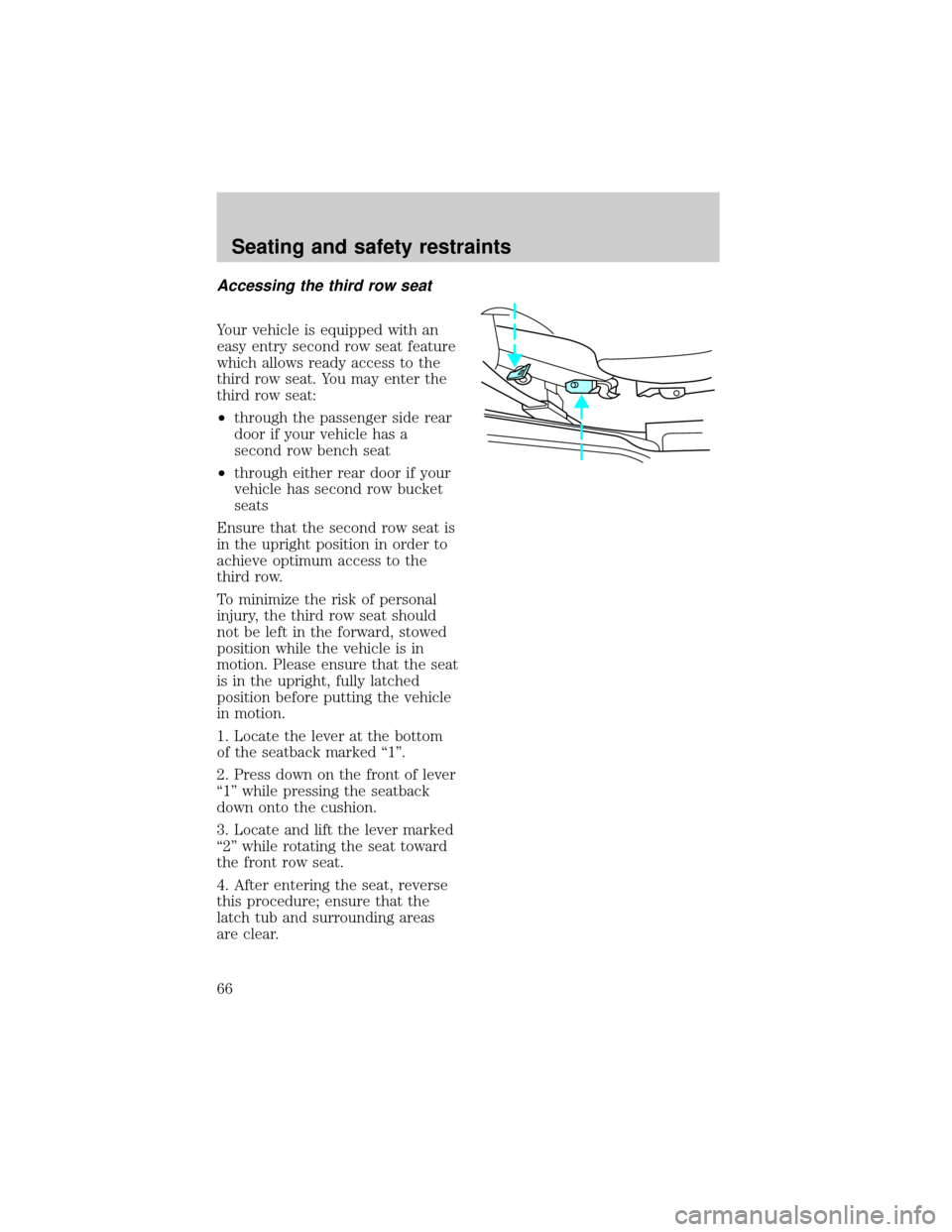Page 26 of 216

²FLR & DEF-Distributes outside
air through the windshield
defroster ducts and the floor
ducts. Heating and air
conditioning capabilities are
provided in this mode. For
added customer comfort, the air
distributed through the floor
ducts will be slightly warmer
than the air sent to the
windshield defroster ducts. If
the temperature is about 10ÉC
(50ÉF) or higher, the air
conditioner will automatically
dehumidify the air to prevent
fogging.
²DEF
-Distributes outside
air through the windshield
defroster ducts. It can be used
to clear ice or fog from the
windshield. If the temperature is
about 10ÉC (50ÉF) or higher, the
air conditioner will automatically
dehumidify the air to prevent
fogging.
Operating tips
²In humid weather, select DEF
before driving. This will
prevent your windshield from
fogging. After a few minutes,
select any desired position.
²To prevent humidity buildup
inside the vehicle, don't drive
with the climate control system
in the OFF position.
²Don't put objects under the
front seat that will interfere with
the airflow to the back seats (if
equipped).
Controls and features
26
Page 60 of 216
SEATING
Using the manual lumbar
support
Turn the lumbar support control
counterclockwise to increase
firmness.
Turn the lumbar support control
clockwise to increase softness.
Front seats
Never adjust the driver's
seat or seatback when the
vehicle is moving.
Do not pile cargo higher
than the seatbacks to
avoid injuring people in a
collision or sudden stop.
Always drive and ride with
your seatback upright and
the lap belt snug and low across
the hips.
Seating and safety restraints
60
Page 63 of 216
REAR SEATS
Head restraints
Push or pull the head rests to the
desired position.
Rear folding bench seat
(if equipped)
Folding down the rear seats
Ensure that no objects such as
books, purses or briefcases are on
the floor in front of the second row
seats before folding them down.
Move front passenger seat forward
so that the second row seat head
rest clears the front seat.
For assistance, refer to the label
located on the lower position of
the opening.
1. Locate handle below the seat
cushion near the bottom of the
door side cushion (this handle is
marked ªAº).
2. Lift the handle and push the
seatback toward the front of the
vehicle.
Seating and safety restraints
63
Page 64 of 216
3. Press the green control on the
seatback to release the closeout
panel. Rotate the panel to closeout
the space in the floor.
4. Once the second row seats are
in the down position, the front
seats may be readjusted.
Returning the seat to upright
Always latch the vehicle
seat to the floor, whether
the seat is occupied or empty. If
not latched, the seat may cause
injury during a sudden stop.
1. Rotate the closeout panel onto
the seatback and press the black
control (adjacent to the green
control) to lock.
2. Locate and lift the handle
marked ªAº.
3. Pull on the seatback while lifting
the handle to lift the seat into the
upright position.
Seating and safety restraints
64
Page 66 of 216

Accessing the third row seat
Your vehicle is equipped with an
easy entry second row seat feature
which allows ready access to the
third row seat. You may enter the
third row seat:
²through the passenger side rear
door if your vehicle has a
second row bench seat
²through either rear door if your
vehicle has second row bucket
seats
Ensure that the second row seat is
in the upright position in order to
achieve optimum access to the
third row.
To minimize the risk of personal
injury, the third row seat should
not be left in the forward, stowed
position while the vehicle is in
motion. Please ensure that the seat
is in the upright, fully latched
position before putting the vehicle
in motion.
1. Locate the lever at the bottom
of the seatback marked ª1º.
2. Press down on the front of lever
ª1º while pressing the seatback
down onto the cushion.
3. Locate and lift the lever marked
ª2º while rotating the seat toward
the front row seat.
4. After entering the seat, reverse
this procedure; ensure that the
latch tub and surrounding areas
are clear.
Seating and safety restraints
66
Page 71 of 216
It is extremely dangerous
to ride in a cargo area,
inside or outside of a vehicle. In
a collision, people riding in these
areas are more likely to be
seriously injured or killed. Do not
allow people to ride in any area
of your vehicle that is not
equipped with seats and safety
belts. Be sure everyone in your
vehicle is in a seat and using a
safety belt properly.
Each seating position in
your vehicle has a specific
safety belt assembly which is
made up of one buckle and one
tongue that are designed to be
used as a pair. 1) Use the
shoulder belt on the outside
shoulder only. Never wear the
shoulder belt under the arm. 2)
Never swing it around your neck
over the inside shoulder. 3)
Never use a single belt for more
than one person.
Combination lap and shoulder
belts
1. To fasten, insert the tongue into
the slot in the buckle.
Seating and safety restraints
71
Page 73 of 216
When to use the automatic
locking mode
²When a tight lap/shoulder fit is
desired.
²Anytimea child safety seat is
installed in the vehicle. Refer to
Safety Restraints for Children
orSafety Seats for Children
later in this chapter.
How to use the automatic
locking mode
²Buckle the combination lap and
shoulder belt.
²Grasp the shoulder portion and
pull downward until the entire
belt is extracted.
²Allow the belt to retract. As the
belt retracts, you will hear a
Seating and safety restraints
73
Page 84 of 216
![FORD EXPEDITION 1998 1.G Owners Manual younger and who weigh 18 kg
[40 lbs] or less), you must put
them in safety seats made
especially for children. Check your
local and state or provincial laws
for specific requirements regarding
the saf FORD EXPEDITION 1998 1.G Owners Manual younger and who weigh 18 kg
[40 lbs] or less), you must put
them in safety seats made
especially for children. Check your
local and state or provincial laws
for specific requirements regarding
the saf](/manual-img/11/4906/w960_4906-83.png)
younger and who weigh 18 kg
[40 lbs] or less), you must put
them in safety seats made
especially for children. Check your
local and state or provincial laws
for specific requirements regarding
the safety of children in your
vehicle.
Never let a passenger hold
a child on his or her lap
while the vehicle is moving. The
passenger cannot protect the
child from injury in a collision.
Always follow the instructions and
warnings that come with any infant
or child restraint you might use.
When possible, place children in
the rear seat of your vehicle.
Accident statistics suggest that
children are safer when properly
restrained in the rear seating
positions than in the front seating
position.
Children and safety belts
Children who are too large for
child safety seats (as specified by
your child safety seat
manufacturer) should always wear
safety belts.
Follow all the important safety
restraint and air bag precautions
that apply to adult passengers in
your vehicle.
If the shoulder belt portion of a
combination lap and shoulder belt
can be positioned so it does not
cross or rest in front of the child's
Seating and safety restraints
84